Douglas DC-4
| DC-4 | |
|---|---|
 | |
| Douglas DC-4 of Pacific Western Airlines in 1959 | |
| Role | Airliner/transport aircraft |
| National origin | United States |
| Manufacturer | Douglas Aircraft Company |
| First flight | 14 February 1942 (production series)[1] |
| Status | Active |
| Produced | 1942 – August 1947 |
| Number built | 80[2] DC-4 and 1,163 C-54/R5D |
| Developed from | Douglas DC-4E |
| Variants | C-54 Skymaster Canadair North Star Aviation Traders ATL-98 Carvair |
| Developed into | Douglas DC-6 |
The Douglas DC-4 is a four-engine (piston) propeller-driven airliner developed by the Douglas Aircraft Company. Military versions of the plane, the C-54 and R5D, served during World War II, in the Berlin Airlift and into the 1960s. From 1945, many civil airlines operated the DC-4 worldwide.
Design and development
After the DC-4E proved to be complicated to maintain and uneconomical to operate, Douglas responded to requests by Eastern Air Lines and United Air Lines for a smaller and simpler replacement. Before the definitive DC-4 could enter service, the entry of the United States into World War II caused production to be channeled to its military, with United States Army Air Forces aircraft designated C-54 Skymaster and United States Navy aircraft designated R5D. The first, a C-54, flew from Clover Field in Santa Monica, California on 14 February 1942.
A total of 1,163 C-54/R5Ds were built for the United States military between 1942 and January 1946; another 79 DC-4s were built postwar. A variant was also built in Canada postwar as the Canadair North Star.
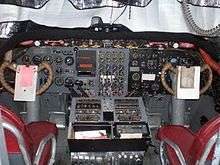
Operational history
The DC-4/C-54 proved a popular and reliable type, 1245 being built between May 1942 and August 1947, including 79 postwar DC-4s. Several remain in service as of 2014. One current operator is Buffalo Airways of Yellowknife, Northwest Territories.[3]
Douglas continued to develop the type during the war in preparation for a return to airline use when peace returned. The type's sales prospects were affected when 500 wartime ex military C-54s and R5Ds came onto the civil market, many being converted to DC-4 standard by Douglas. DC-4s were a favorite of charter airlines such as Great Lakes Airlines, North American Airlines, Universal Airlines and Transocean Airlines. In the 1950s Transocean (Oakland, California) was the largest civil C-54/DC-4 operator.
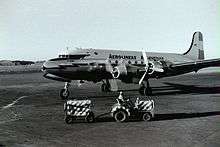
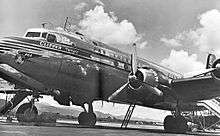
Douglas produced 79 new-build DC-4s between January 1946 and August 9, 1947, the last example being delivered to South African Airways. Pressurization was an option, but all civil DC-4s (and C-54s) were built un-pressurized.
Purchasers of new-build DC-4s included Pan American Airways, National Airlines, Northwest Airlines and Western Airlines in the USA, and KLM Royal Dutch Air Lines, Scandinavian Airlines System, Iberia Airlines of Spain, Swissair, Air France, Sabena Belgian World Airlines, Cubana de Aviación, Avianca, Aerolíneas Argentinas, Aeropostal of Venezuela (1946) and South African Airways overseas.[4] Several airlines used new-build DC-4s to start scheduled transatlantic flights between Latin America and Europe. Among the earliest were Aerolíneas Argentinas (1946), Aeropostal of Venezuela (1946), Iberia Airlines of Spain (1946), and Cubana de Aviación (1948).
Basic prices for a new DC-4 in 1946-7 was around £140,000-£160,000. In 1960 used DC-4s were available for around £80,000.[5]
Variants

- DC-4
- Main production airliner, postwar.
- Canadair North Star
- Canadian production of a Rolls-Royce Merlin - powered variant, plus a single Pratt & Whitney R-2800 - powered aircraft.
- Aviation Traders Carvair
- British cargo and car ferry adaptation.
Operators
Accidents and incidents
Survivors
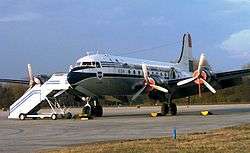
Very few DC-4s remain in service today.[6] The last two passenger DC-4s operating worldwide are based in Johannesburg, South Africa. They fly with old South African Airways (SAA) colors. They are ZS-AUB "Outeniqua" and ZS-BMH "Lebombo" and are owned by the South African Airways Museum Society[7][8] and operated by Skyclass Aviation,[9] a company specializing in classic and VIP charters to exotic destinations in Africa. A 1944 built DC-4 is currently being restored in New South Wales, Australia.[10] Buffalo Airways in Canada's Northwest Territories operates roughly a dozen DC-4s (former C-54s of various versions) 4 for hauling cargo and 3 for aerial firefighting.[11] A 1945 built DC-4 (C-54E) c/n 27370 is currently operating as a flying museum to the Berlin Airlift. Called the "Spirit of Freedom", it has been touring the world for nearly 20 years.[12] Two fuel carriers; Brooks Fuel[13] and Alaska Air Fuel[14] also operate the DC4 in Alaska. One ex-Buffalo DC4[15] (N55CW c/n 10673, currently registered to AIRCRAFT GUARANTY CORP TRUSTEE) is fitted with spray bars on top of the wings and is currently based in Florida on standby for oil pollution control.[16]
Specifications (DC-4-1009)
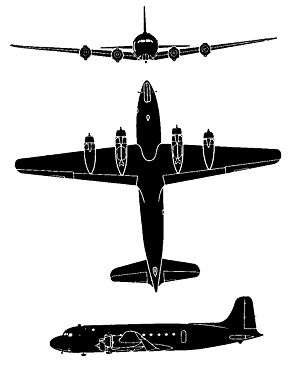
General characteristics
- Crew: four
- Capacity: 40 to 80 passengers[1]
- Length: 93 ft 10 in (28.6 m)
- Wingspan: 117 ft 6 in (35.8 m)
- Height: 27 ft 6 in (8.38 m)
- Wing area: 1,460ft² (135.6 m²)
- Empty weight: 43,300 lb (19,640 kg)
- Loaded weight: 63,500 lb (28,800 kg)
- Max. takeoff weight: 73,000 lb (33,100 kg)
- Powerplant: 4 × Pratt & Whitney R-2000 radial engine, 1,450 hp (1,081 kW) each
Performance
- Maximum speed: 280 mph (450 km/h)
- Cruise speed: 227 mph/197kts (365 km/h)
- Range: 4,250 mi (6,839 km)
- Service ceiling: 22,300 ft (6,800 m)
- Wing loading: 43.5 lb/ft² (212.4 kg/m²)
- Power/mass: 10.9 lb/hp (6.6 kg/kW)
See also
- Related development
- Aviation Traders Carvair
- Canadair North Star
- Douglas DC-4E
- Douglas C-54 Skymaster
- Douglas DC-6
- Douglas DC-7
- Aircraft of comparable role, configuration and era
- Related lists
References
- Notes
- 1 2 "History: Products: DC-4/C-54 Skymaster Transport". Boeing. Retrieved 20 January 2015.
- ↑ Piston Engine Airliner Production List 1996
- ↑ Stapleton, Rob. "Brooks Fuel keeps Alaska supplied using legacy aircraft." Alaska Journal of Commerce, August 15, 2009. Retrieved: August 26, 2009.
- ↑ Berry 1967, pp. 70–73.
- ↑ http://www.flightglobal.com/pdfarchive/view/1960/1960%20-%202687.html
- ↑ Blewett 2007, p. 101.
- ↑ ""Outeniqua" Douglas DC-4 1009 ZS-AUB c/n 42984". South African Airways Museum Society. Retrieved 21 January 2015.
- ↑ ""Lebombo" Douglas DC-4 1009 ZS-BMH c/n 43157". South African Airways Museum Society. Retrieved 21 January 2015.
- ↑ "Portfolios: SkyClassic". SkyClass Aviation. 31 March 2014. Retrieved 20 January 2015.
- ↑ Morgan, Ben. "Engineering Underway on the Douglas DC4." hars.org.au. Retrieved: September 21, 2011.
- ↑ "Buffalo Airways Aircraft Fleet". Retrieved 17 November 2015.
- ↑ "Berlin Airlift Historical Foundation". Retrieved 11 February 2015.
- ↑ http://www.ptialaska.net/~brksfuel/
- ↑ http://www.frontiersman.com/news/city-airport-s-future-bright/article_3778a314-8e4c-11e4-b56a-df14b4587ea5.html
- ↑ "Douglas DC-4 "Oil Bomber" Spray Plane at KCGI". seMissourian.com. Retrieved 2016-02-09.
- ↑ http://de.flightaware.com/resources/registration/N55CW
- Bibliography
- Berry, Peter et al. The Douglas DC-4. Tonbridge, Kent, UK: Air-Britain (Historians) Ltd, 1967.
- Blewett, R. Survivors. Coulsden, UK: Aviation Classics, 2007. ISBN 978-0-9530413-4-3.
- Francillon, René. McDonnell Douglas Aircraft Since 1920: Volume I. London: Putnam, 1979. ISBN 0-87021-428-4.
- Pearcy, Arthur. Douglas Propliners: DC-1–DC-7. Shrewsbury, UK: Airlife Publishing, 1995. ISBN 1-85310-261-X.
- Yenne, Bill. McDonnell Douglas: A Tale of Two Giants. Greenwich, Connecticut: Bison Books, 1985. ISBN 0-517-44287-6.
External links
| Wikimedia Commons has media related to Douglas DC-4. |
- The last DC-4s flying passenger service http://www.saamuseum.co.za/skyclass-aviation-operate-our-dc-3-a-dc-4.html
- Vintage Wings of Canada Canadair North Star showing RR Merlin installation
- Life magazine photos by Eliot Elisofon of first production batch of DC-4s being completed (partly outdoors) as military C-54s (note absence of cargo door on these), and including early air-to-air photos of 42-10237 the first DC-4/C-54 to fly